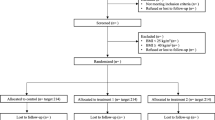Abstract
An investigation in a randomized population-based Swedish study with 564 participants aged 18–80 years showed that mean physical activity levels obtained using short message service (SMS) by means of cell phones (n = 171) were equal to corresponding levels obtained when sending identical questions by web (n = 182) or paper (n = 211). The response rates were similar for the SMS, web and paper groups.


Similar content being viewed by others
Abbreviations
- PAL:
-
Physical activity level
- SMS:
-
Short message service
- BMI:
-
Body mass index
References
Lagerros YT, Lagiou P. Assessment of physical activity and energy expenditure in epidemiological research of chronic diseases. Eur J Epidemiol. 2007;22(6):353–62.
Warren JM, Ekelund U, Besson H, Mezzani A, Geladas N, Vanhees L. Experts Panel. Assessment of physical activity—a review of methodologies with reference to epidemiological research: a report of the exercise physiology section of the European Association of Cardiovascular Prevention and Rehabilitation. Eur J Cardiovasc Prev Rehabil. 2010;17(2):127–39.
Neilson HK, Robson PJ, Friedenreich CM, Csizmadi I. Estimating activity energy expenditure: how valid are physical activity questionnaires? Am J Clin Nutr. 2008;87(2):279–91.
Andersen LB, Harro M, Sardinha LB, et al. Physical activity and clustered cardiovascular risk in children: a cross-sectional study (The European Youth Heart Study). Lancet. 2006;368(9532):299–304.
Ruiz JR, Ortega FB, Martinez-Gomez D, et al. Objectively measured physical activity and sedentary time in European adolescents: the helena study. Am J Epidemiol. 2011;174(2):173–84.
Troiano RP, Berrigan D, Dodd KW, Masse LC, Tilert T, McDowell M. Physical activity in the United States measured by accelerometer. Med Sci Sports Exerc. 2008;40(1):181–8.
Ekman A, Litton JE. New times, new needs; e-epidemiology. Eur J Epidemiol. 2007;22:285–92.
International Telecommunication Union. The world in 2010: ICT facts and figures. 2012. http://www.itu.int/ITU-D/ict/material/FactsFigures2010.pdf. Accessed 20 Mar 2012.
Freifeld CC, Chunara R, Mekaru SR, et al. Participatory epidemiology: use of mobile phones for community-based health reporting. PLoS Med. 2010;7(12):e1000376.
Hu SS, Balluz L, Battaglia MP, Frankel MR. Improving public health surveillance using a dual-frame survey of landline and cell phone numbers. Am J Epidemiol. 2011;173(6):703–11.
Voigt LF, Schwartz SM, Doody DR, Lee SC, Li CI. Feasibility of including cellular telephone numbers in random digit dialing for epidemiologic case-control studies. Am J Epidemiol. 2011;173(1):118–26.
Wu J, Jiang C, Liu Z, Houston D, Jaimes G, McConell R. Comparison of multiple portable GPS units for use in epidemiological studies. Epidemiology. 2010;22(1 January Supplement):S195.
Sternfeld B, Jiang S-F, Picchi T, Chasan-Taber L, Ainsworth B, Quesenberry CP Jr. Evaluation of a cell-phone based physical activity diary. Med Sci Sports Exerc. 2012;44(3):487–95.
Bexelius C, Lof M, Sandin S, Trolle Lagerros Y, Forsum E, Litton JE. Measures of physical activity using cell phones: validation using criterion methods. J Med Internet Res. 2010;12(1):e2.
Bexelius C, Sandin S, Trolle-Lagerros Y, Litton J-E, Löf M. Estimation of physical activity levels using cell phones: a comparison with accelerometry for evaluation of between-subject and within-subject variations. J Med Internet Res. 2011;13(3):e70.
Hauck W, Anderson S. A new statistical procedure for testing equivalence in two-group comparative bioavailability trials. J Pharmacokinet Biopharm. 1984;12:83–91.
Schuirmann D. A comparison of the two one-sided tests procedure and the power approach for assessing the equivalence of average bioavailability. J Pharmacokinet Biopharm. 1987;15(6):657–80.
Curtin R, Presser SS, Singer E. Changes in telephone survey nonresponse over the past quarter century. Public Opin Q. 2005;69(1):87–98.
de Heer W. International response trends: results of an international survey. J Off Stat. 1999;15(2):129–42.
Galea S, Tracy M. Participation rates in epidemiologic studies. Ann Epidemiol. 2007;17(9):643–53.
Tolonen H, Helakorpi S, Talala K, Helasoja V, Martelin T, Prattala R. 25 year trends and socio-demographic differences in response rates: Finnish adult health behaviour survey. Eur J Epidemiol. 2006;21(6):409–15.
Fondell E, Lagerros YT, Sundberg CJ, et al. Physical activity, stress, and self-reported upper respiratory tract infection. Med Sci Sports Exerc. 2011;43(2):272–9.
Lehman E. Nonparametrics: statistical methods based on ranks. New York: Holden-Day; 1975.
Edwards PJ, Roberts I, Clarke MJ, et al. Methods to increase response to postal and electronic questionnaires. Cochrane Database Syst Rev. 2009 Jul 8;(3):MR000008.
Wanner M, Martin-Diener E, Bauer G, Braun-Fahrlander C, Martin BW. Comparison of trial participants and open access users of a web-based physical activity intervention regarding adherence, attrition, and repeated participation. J Med Internet Res. 2010;12(1):e3.
The Swedish Post and Telecom Agency (PTS). The use of telephones and internet in the Swedish population 2010. http://www.pts.se/upload/Rapporter/Tele/2010/2010-25 individundersokning-2010.pdf. Accessed 20 Mar 2012.
Hu FB, Stampfer MJ, Rimm E, et al. Dietary fat and coronary heart disease: a comparison of approaches for adjusting for total energy intake and modeling repeated dietary measurements. Am J Epidemiol. 1999;149(6):531–40.
Dugas LR, Harders R, Merrill S, et al. Energy expenditure in adults living in developing compared with industrialized countries: a meta-analysis of doubly labeled water studies. Am J Clin Nutr. 2011;93(2):427–41.
Black AE, Coward WA, Cole TJ, et al. Human energy expenditure in affluent societies: an analysis of 574 doubly-labelled water measurements. Eur J Clin Nutr. 1996;50(2):72–92.
Ainsworth BE, Haskell WL, Whitt MC, et al. Compendium of physical activities: an update of activity codes and MET intensities. Med Sci Sports Exerc. 2000;32(9 Suppl):S498–504.
Acknowledgments
The authors would like to thank all study participants, Åsa Neij for help with data collection as well as Johan Cederlund and Jan Fjellström for help with the web and cell phone application. This work was supported by the Swedish Research Council (2008-4322), and Karolinska Institutet.
Conflict of interest
The authors declare that they have no conflict of interest.
Author information
Authors and Affiliations
Corresponding author
Rights and permissions
About this article
Cite this article
Lagerros, Y.T., Sandin, S., Bexelius, C. et al. Estimating physical activity using a cell phone questionnaire sent by means of short message service (SMS): a randomized population-based study. Eur J Epidemiol 27, 561–566 (2012). https://doi.org/10.1007/s10654-012-9708-4
Received:
Accepted:
Published:
Issue Date:
DOI: https://doi.org/10.1007/s10654-012-9708-4




